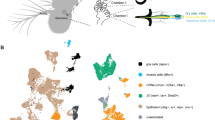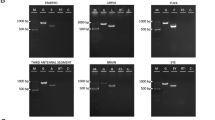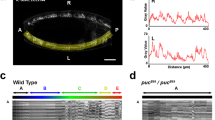Abstract
MANY mutations in Drosophila melanogaster cause the development of body parts in inappropriate places. Several of these homoeotic mutations (reviewed in ref. 1) result in the appearance of leg bristles and other leg cuticular structures in place of their antennal counterparts. In the mutant spineless-aristapedia (ssa, 3–58.5) the antennal arista is replaced by tarsal segments2; the mutations Antennapedia (Antp, 3–48) and Nasobemia (Ns, 3–48) produce a more extreme transformation: most of the antennal cuticular structures are transformed into leg cuticle, and, in the latter, part of the head cuticle is replaced by sternopleural cuticle3,4. In insects the sensory neurones are derived from epidermal cells5. When sensory epidermis is surgically transplanted to ectopic sites, neurones develop from it and form connections with the central nervous system6. These neurones act according to the type of epidermis from which they are derived rather than according to the position in which they develop6. In homoeotic mutants cuticular structures develop at ectopic sites as a result of genetic modification. In this report I examine whether in homoeotic mutants sensory neurones are formed, and, if so, whether they behave according to the homoeotic structures that develop, or according to their general position in the body.
This is a preview of subscription content, access via your institution
Access options
Subscribe to this journal
Receive 51 print issues and online access
$199.00 per year
only $3.90 per issue
Buy this article
- Purchase on Springer Link
- Instant access to full article PDF
Prices may be subject to local taxes which are calculated during checkout
Similar content being viewed by others
References
Gehring, W. J., and Noethiger, R., in Developmental Systems: Insects (edit. by Counce, S. J., and Waddington, C. H.)(Academic, London, 1973).
Balknschina, E., Arch. Entw Mech. Org., 115, 448–463 (1929).
Lewis, E. B., Drosophila Inf. Serv. 30, 76–77 (1956).
Gehring, W. J., Arch. Julius Klaus Stiff. Vererb. Forsch., 41, 44–54 (1966).
Wigglesworth, V. B., Q. Jl microsc. Sci., 94, 93–112 (1953).
Palka, J., and Schubiger, M., Proc. natn. Acad. Sci. U.S.A., 72, 966–969 (1975).
Minnich, D. E., Biol. Bull. mar. biol. Lab. Woods Hole, 51, 166–178 (1926).
Dethier, V. G., Solomon, R. I., and Turner, L. H., J. comp. physiol. Psychol., 60. 303–333 (1965).
Dethier, V. G., Q. Rev. Biol., 30, 348–371 (1955).
Postlethwait, J. H., and Schneiderman, H. A., Devl Biol., 25, 606–640 (1971).
Author information
Authors and Affiliations
Rights and permissions
About this article
Cite this article
DEAK, I. Demonstration of sensory neurones in the ectopic cuticle of spineless-aristapedia, a homoeotic mutant of Drosophila. Nature 260, 252–254 (1976). https://doi.org/10.1038/260252a0
Received:
Accepted:
Issue Date:
DOI: https://doi.org/10.1038/260252a0
This article is cited by
-
Taste and pheromone perception in the fruit fly Drosophila melanogaster
Pflügers Archiv - European Journal of Physiology (2007)
-
The organization of the chemosensory system in Drosophila melanogaster: a rewiew
Cell and Tissue Research (1994)
-
The homeotic genespineless-aristapedia affects geotaxis inDrosophila melanogaster
Behavior Genetics (1992)
-
Closely linked lesions in a region of the X chromosome affect central and peripheral steps in gustatory processing in Drosophila
Molecular and General Genetics MGG (1991)
-
Deletion mapping of a new gustatory mutant inDrosophila melanogaster
Experientia (1985)
Comments
By submitting a comment you agree to abide by our Terms and Community Guidelines. If you find something abusive or that does not comply with our terms or guidelines please flag it as inappropriate.



